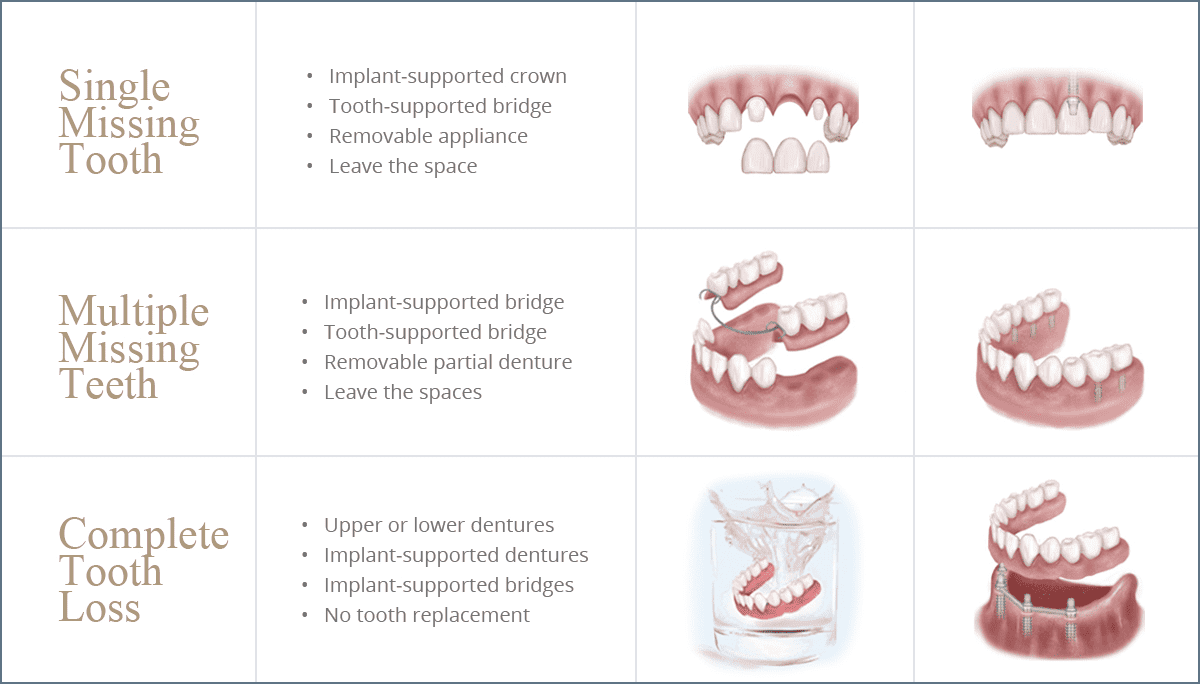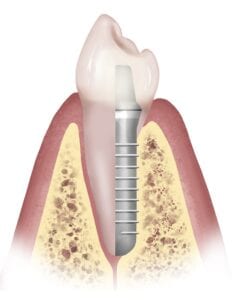 Your tooth is made up of two parts – the root, which is embedded in your jawbone, and the crown, which is the part of the tooth you can see. When a tooth is lost or removed, the bone that previously surrounded the tooth root begins to resorb, or deteriorate.
Your tooth is made up of two parts – the root, which is embedded in your jawbone, and the crown, which is the part of the tooth you can see. When a tooth is lost or removed, the bone that previously surrounded the tooth root begins to resorb, or deteriorate.
Dental implants are substitute tooth roots that function like natural tooth roots, stimulating bone growth and providing a strong foundation for replacement teeth.
Why Are Dental Implants the Preferred Method of Tooth Replacement?
Dental implants have become standard of care and the preferred method of tooth replacement for several important reasons:
- No other treatment option prevents the bone resorption/deterioration that occurs when a tooth is lost or removed.
- This is the only tooth replacement option that preserves the adjacent teeth, as opposed to cutting them down to place a bridge or hooking a partial denture to them.
- Dental implants have by far the best long-term success rates of any treatment option – and this has been documented in the scientific literature for over four decades.
- Since dental implants are designed to last a lifetime, there is rarely a need for additional treatment. With other forms of tooth replacement that need to be replaced every 5 to 10 years, additional dentistry is almost always necessary in the future. As a result, dental implant treatment is the most cost-effective option long-term.
Benefits of Dental Implants
While there are other treatment options for replacing missing teeth, dental implants have numerous unique benefits for patients:
Designed to Last a Lifetime. Because dental implants are designed to last a lifetime, they have a better long-term success rate than any other tooth-replacement option.
Documented clinical research demonstrates that dental implants have a success rate of over 95%, which is significantly higher than tooth-supported bridges and partial or full dentures.
Preserves Bone and Facial Structures. Bone resorption, or deterioration, is one of the most serious consequences of missing teeth. By replacing the root of your tooth with a dental implant, your jawbone and smile retain their shape.
If you are missing all of your teeth, replacing them with implant-supported replacement teeth will preserve the integrity of your facial structures and prevent the shrinkage of your jaws and the appearance of a collapsed face.
A Healthier Smile. Tooth-supported bridges and partial dentures can damage your teeth over time. With dental implants, it is not necessary to compromise the health of any other teeth.
In order to place a bridge, the adjacent teeth are cut down, which compromises the long-term health of the teeth. Partial dentures hook onto teeth, which can cause them to loosen to the point where they have to be removed.
Natural Appearance. Dental implants were developed to replicate the appearance of your natural teeth – and preserve your bone to maintain the natural appearance of your smile.
Your surgeon will be able to place the dental implants in the precise position to enable your dentist to create a beautiful crown that matches the shape and shade of your natural teeth.
Ultimately, dental implants will function the same way as your natural teeth, allowing you to smile with confidence and enjoy any type of food.
For more information about the benefits of dental implants visit The Dental Implant Guide.
How Do Dental Implants Compare to Other Options?
Treatment options for replacing missing teeth include the following:
There are disadvantages to replacing teeth with a bridge, a partial denture, dentures, or simply leaving the space with no replacement, which affects the jawbone and surrounding teeth. Some of the consequences include the following:
Tooth-Supported Bridges:
- Tooth structure is removed to fit crowns onto adjacent teeth, compromising
the long-term health of these teeth. - Bridges need to be replaced about every 10 years according to the American Dental Association.
- Replacing bridges often leads to additional treatment.
- Bridges do not prevent the bone resorption, or deterioration that occurs when a tooth is lost or removed.
Partial Dentures:
- Partial dentures hook onto adjacent teeth for support, causing pressure that loosens the teeth
- Adjacent teeth often need to be removed as they become loose.
- Partials usually need to be replaced every 3 to 5 years.
- Partials accelerate the bone resorption, or deterioration resulting from missing teeth.
Dentures:
- Dentures rarely fit well, which can cause sores on the gum tissue that are painful.
- Dentures accelerate the bone resorption, or deterioration that occurs when teeth are missing.
- Severe bone resorption causes facial structures to collapse, increasing the appearance of wrinkles and shrinking the distance between the nose and mouth.
- Dentures must be relined periodically as the jawbone resorbs.
- Dentures usually need to be replaced every 5 years.
No Treatment:
- Leaving a gap from tooth loss causes adjacent teeth to drift into the space.
- Teeth in the opposite jaw drift either downward or upward into the space.
- Tooth loss in the back of the mouth caused teeth to move forward and splay out in the front of the mouth.
- Teeth that are not in alignment can cause damage to other teeth.
Are There Any Disadvantages With Dental Implants?
Dental implants are the preferred method of tooth replacement because of the many advantages they provide for people with lost or missing teeth, compared to all other treatment options. However, there are a few disadvantages:
- Dental implant treatment requires surgery and a recovery period.
- It takes longer to complete dental implant treatment than other options.
- Dental implant treatment can be more costly upfront. However, it becomes more cost-effective than other options as additional treatment is needed.
How Will My Surgeon Determine Whether I Am a Candidate for Dental Implants?
Dentists throughout the Baltimore area refer their patients who need dental implants to the Maryland Center for Oral Surgery & Dental Implants because our Oral Surgeons are some of the most experienced dental implant surgeons in the country.
In order to determine whether you are a candidate for dental implants, you will need a surgical evaluation and consultation.
During your consultation, your surgeon will evaluate the following factors:
- Quality and quantity of available bone to support your dental implants
- Number of dental implants needed to create the optimal result
- Other procedures that may be necessary to prepare the surgical site
- Your health and dental histories, as well as results of the oral examination
Our surgeons utilize leading-edge technology, such as 3D cone beam imaging to obtain the most accurate, detailed view of your teeth, bone, and facial structures. This enables the surgeons to provide the most precise diagnosis and treatment planning available.
Once your surgeon has completed the comprehensive examination and diagnosis, if it is determined that you are a candidate for dental implants, your surgeon will discuss your treatment options with you.
How Are Dental Implants Placed and Restored?
Once your surgeon has developed your ideal treatment plan and determined whether you need additional procedures to obtain the optimal end result, you’ll be ready to schedule your surgical procedures.
If the tooth to be replaced has not yet been removed, your first surgical procedure will be to remove the tooth. If you do not have sufficient bone for a dental implant, you will need bone grafting to add bone to the site where the implant will be placed.
In certain cases, the tooth removal and bone graft can be completed at the same time as the implant placement. In other cases, the implant will be placed several weeks after the surgical removal of the tooth and bone graft.
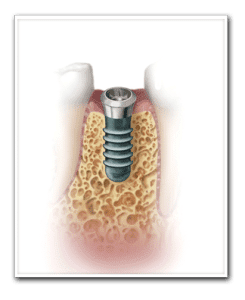
Implant Placement. Your surgeon will administer anesthesia to prevent any sensation during surgery. Utilizing a gentle technique, your surgeon will prepare the surgical site and place the dental implant in the proper position. A small cover screw will then be attached to the implant. A temporary replacement tooth (or teeth) will be inserted following surgery. The implant will be left undisturbed for several weeks to a few months, to allow the bone to remodel around the implant.
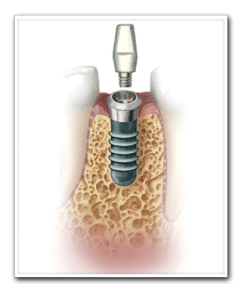
Abutment Attachment. Once the bone has fused to the implant and formed a strong biological bond, you will return to the surgeon’s office to have a small connector post attached to each implant. Your new replacement teeth will be attached to these abutments. Your surgeon and dentist will determine the best abutment to use for your case. This is often a custom abutment, which is utilized to enable your dentist to design the ideal shape of your replacement teeth.
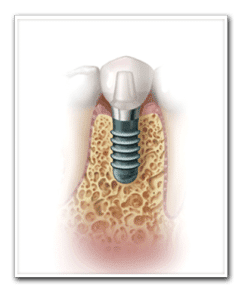
Replacement Teeth. The final phase of treatment is designing and fabricating the final replacement crown, bridge, or set of teeth. Your dentist will take impressions of your teeth and the abutments and send them to a dental technician, who will create the replacement teeth. Your dentist will also determine the best shade to match your natural teeth. Once the technician has fabricated your new teeth, your dentist will attach them to the abutments, completing your treatment.
If you are ready to enhance the quality of your life, call (410) 363-7780 to schedule a consultation with one of our oral surgeons to see if you are a candidate for a Smile Complete full-arch transformation


